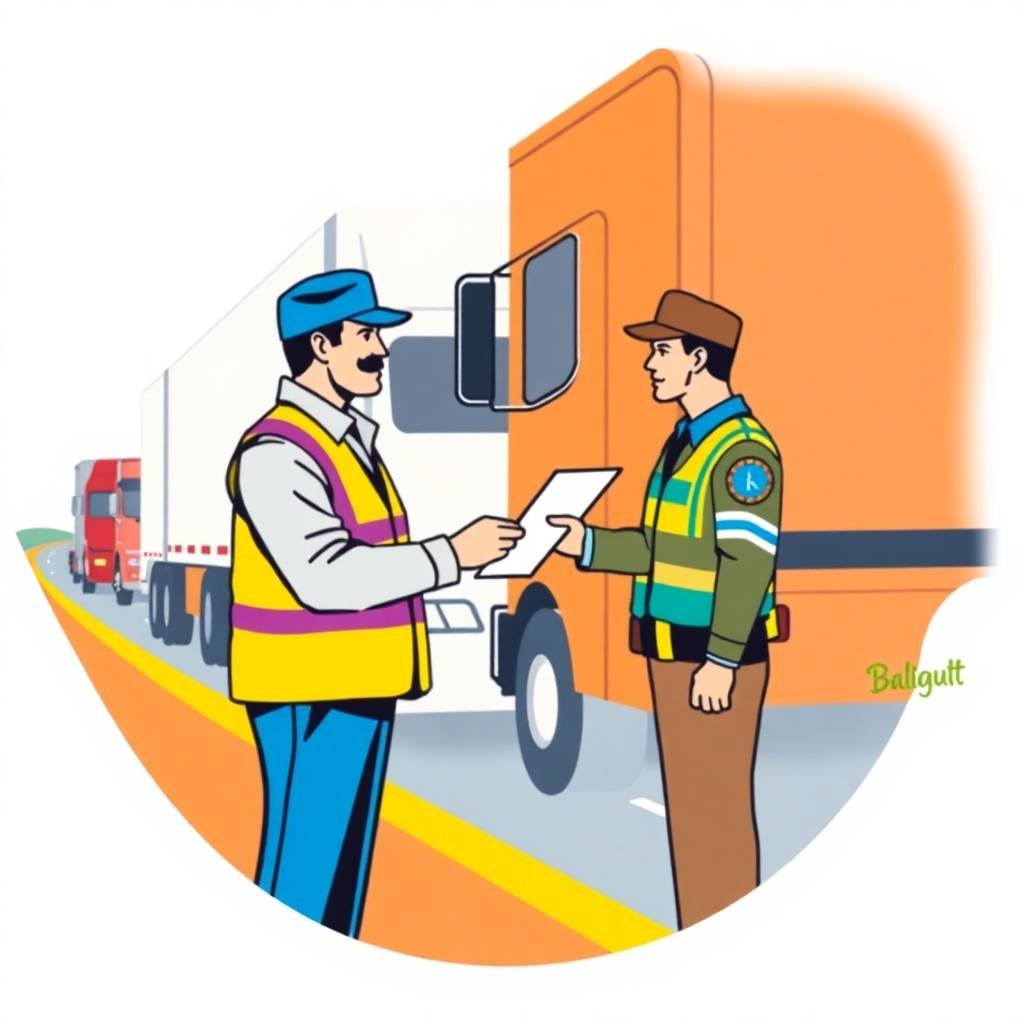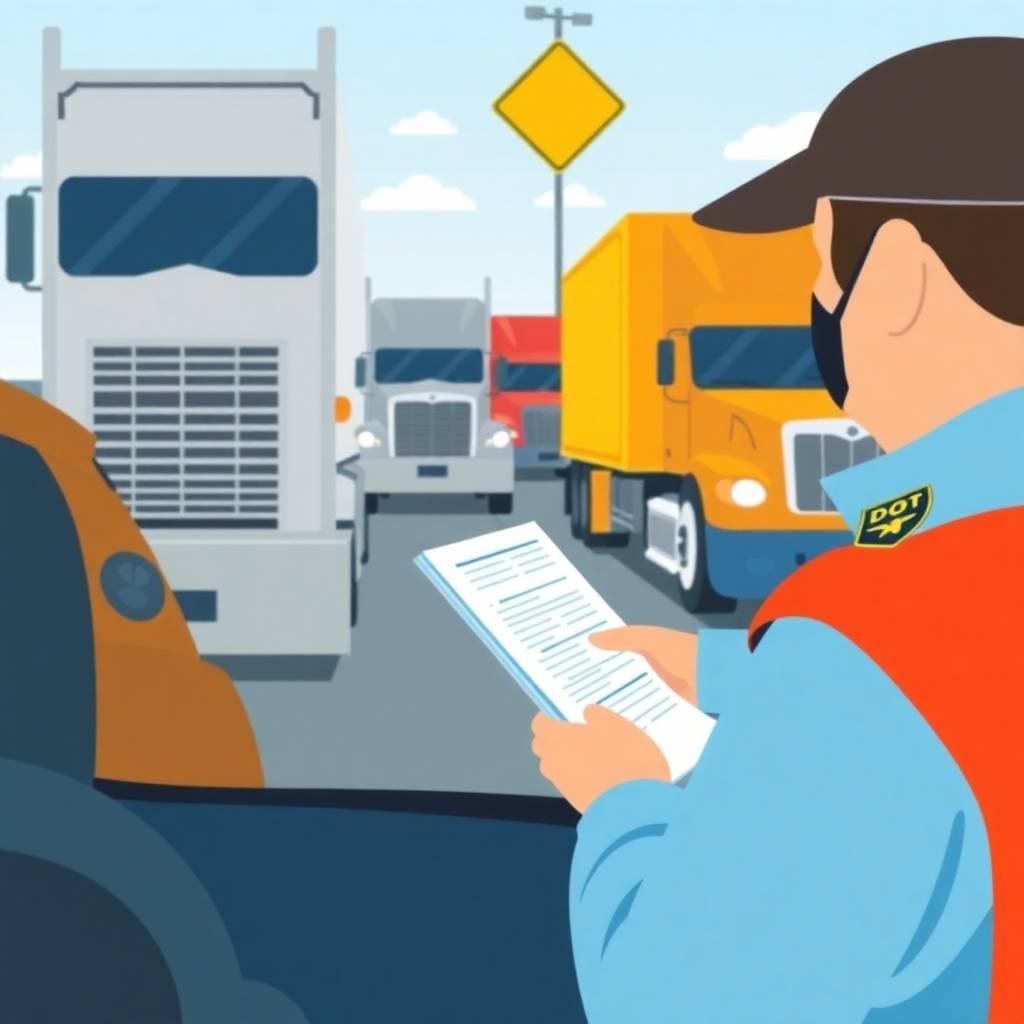1. Understand How CSA Intervention Thresholds Are Calculated
For motor carriers and owner-operators, CSA Intervention Thresholds are a critical factor in determining compliance with federal safety regulations. The Compliance, Safety, Accountability (CSA) program, managed by the Federal Motor Carrier Safety Administration (FMCSA), uses data-driven insights to identify high-risk carriers based on performance in seven Behavior Analysis and Safety Improvement Categories (BASICs). Understanding how these thresholds are calculated is essential to maintaining a strong safety record and avoiding interventions.
What Are CSA Intervention Thresholds?
CSA Intervention Thresholds are performance benchmarks used to determine when a motor carrier may be subject to enforcement actions. These thresholds vary depending on the BASIC category and the type of carrier. For example, passenger carriers and hazmat haulers have lower thresholds due to higher risk. The thresholds are based on percentile rankings within each BASIC, comparing carriers of similar size and operation types.
To stay compliant, carriers must frequently monitor their BASIC scores using FMCSA’s Safety Measurement System (SMS). When scores exceed the threshold, the FMCSA may initiate interventions such as warning letters, audits, or even out-of-service orders.
Key Factors in Threshold Calculation
CSA scores are calculated using a combination of inspection results, crash reports, and violations. Factors like time-weighted severity of violations and number of relevant inspections are weighed heavily. A comprehensive DOT Compliance Checklist can help carriers stay within safe limits.
Common violations that trigger CSA Intervention Thresholds include issues found in Driver Qualification Files, drug and alcohol testing compliance, and DQ file violations. Learn more about proper DQ File Setup and Monitoring to avoid such penalties.
How to Avoid Exceeding CSA Thresholds
Consistent adherence to FMCSA guidelines is the best way to stay under CSA Intervention Thresholds. Regular audits, robust safety training, and proper documentation go a long way. We offer DOT Audit Preparation and Drug and Alcohol Testing Management services to support your compliance strategy.
Other helpful services include:
Learn about our complete FMCSA Compliance Services for Owner Operators for tailored assistance.
Staying Updated on FMCSA Policies
Keeping up with FMCSA policy updates is crucial. Visit Truckers Compliance Hub to read the latest posts or browse guides like:
- FMCSA Clearinghouse Compliance
- Pre-Employment DOT Drug Testing Requirements
- Random DOT Drug Testing Requirements
- Driver Drug and Alcohol Testing Program
- DOT Audit Preparation 2025
- FMCSA Compliance Mistakes
- FMCSA Compliance Requirements for Trucking Companies
For authoritative government resources, explore Transportation.gov or FMCSA.gov.
Ready to Take Control of Your CSA Score?
If you’re unsure where to start, schedule your appointment with one of our compliance consultants today. We’ll help you understand your CSA Intervention Thresholds, develop a strategy, and keep your operation audit-ready.
For more helpful insights, check out our:
Let Truckers Compliance Hub be your partner in safety, compliance, and CSA success.

2. Prioritize Vehicle Maintenance to Reduce Risk Scores
In the trucking industry, vehicle maintenance is more than a best practice—it’s a regulatory imperative that directly impacts your CSA Intervention Thresholds. The FMCSA’s Compliance, Safety, Accountability (CSA) program evaluates carriers based on safety performance, and the condition of your fleet plays a major role. Poor maintenance can raise your Vehicle Maintenance BASIC score, pushing your company closer to intervention.
Understanding how to proactively manage vehicle maintenance helps reduce risk, avoid costly violations, and stay under CSA Intervention Thresholds. This article outlines key strategies, regulatory expectations, and the value of routine maintenance in keeping your fleet safe and compliant.
Why Vehicle Maintenance Matters for CSA Scores
The CSA Safety Measurement System (SMS) assesses your performance in seven BASIC categories. One of the most scrutinized is Vehicle Maintenance. This category tracks violations such as inoperative brakes, tire tread depth, defective lighting, and more. Frequent or severe violations increase your percentile rank and bring you closer to CSA Intervention Thresholds, which trigger audits or enforcement.
You can learn more about how SMS data impacts your scores in our guide on FMCSA Safety Measurement System (SMS) 2025.
The Connection Between Maintenance and Interventions
CSA interventions begin when your scores surpass the defined CSA Intervention Thresholds. These vary depending on your carrier type and the severity of violations. Reaching these thresholds invites warning letters, offsite audits, and even on-site comprehensive reviews by the FMCSA.
To avoid reaching these thresholds, follow a detailed DOT Compliance Checklist and commit to preventive maintenance. Minor oversights can lead to violations that accumulate over time, eventually harming your safety score.
Common Maintenance Violations That Impact Your Score
Many violations are avoidable with regular inspections and service routines. The most frequent include:
- Inoperative turn signals
- Brake hose chafing or kinks
- Cracked windshields
- Worn tires
- Oil or fluid leaks
For owner-operators, a dedicated DOT Compliance Checklist for Owner Operators can serve as a vital tool to catch issues early.
Neglecting maintenance not only affects your vehicle but also opens you to broader compliance issues such as DQ File Violations and Driver Qualification File Requirements, both of which contribute to CSA Intervention Thresholds.
How to Proactively Stay Below CSA Intervention Thresholds
Proper vehicle maintenance is a strategic investment. To keep your scores low:
- Conduct daily inspections
- Log and resolve minor defects promptly
- Schedule routine preventative maintenance
- Train drivers to spot safety-critical issues
A more comprehensive approach includes services like DQ File Setup and Monitoring, Drug and Alcohol Testing Management, and DOT Audit Preparation.
Don’t wait until a violation occurs. Schedule your appointment with our compliance experts today to evaluate your current maintenance and compliance readiness.
Other Critical Areas Affecting CSA Scores
Vehicle maintenance is only one part of the compliance puzzle. The following areas also influence CSA Intervention Thresholds:
- Drug and Alcohol Testing Compliance
- Pre-Employment DOT Drug Testing Requirements
- Random DOT Drug Testing Requirements
- FMCSA Clearinghouse Compliance
- Driver Drug and Alcohol Testing Program
Explore our full FMCSA Compliance Services for Owner Operators and FMCSA Compliance Help for Trucking Companies for additional support.
Stay Compliant with Professional Support
Avoiding high CSA Intervention Thresholds means staying ahead of all FMCSA regulations. Our team offers a range of services, including:
- UCR Filing Assistance
- IFTA/IRP/BOC-3 Support
- BOC-3 Process Agent Compliance
- IFTA Filing Requirements
- UCR Filing Deadlines
To access all our content, including new and previous articles, visit the Truckers Compliance Hub blog.
You can also review our insights on FMCSA Compliance Mistakes and FMCSA Compliance Requirements for Trucking Companies.
Final Thoughts on Risk Management and Maintenance
A well-maintained fleet is your first defense against crossing CSA Intervention Thresholds. Whether you’re managing a single rig or a full fleet, preventative maintenance, up-to-date files, and consistent training make the difference.
For official regulatory updates, visit Transportation.gov or the FMCSA website.
To learn more about our full range of services, check out:
Don’t let preventable issues jeopardize your business. Book a consultation and get your fleet in top shape today.

3. Master Hours of Service Compliance Before It Affects Your Score
Staying compliant with Hours of Service (HOS) regulations is one of the most critical aspects of avoiding unnecessary violations and keeping your operation below CSA Intervention Thresholds. These thresholds, established by the Federal Motor Carrier Safety Administration (FMCSA), are designed to monitor the safety performance of carriers and drivers. Violations in HOS regulations can significantly affect your BASIC scores, particularly in the Hours-of-Service Compliance category.
Understanding how to manage HOS regulations not only protects your fleet from penalties but also plays a pivotal role in maintaining a healthy safety profile. This article explores how mastering HOS compliance helps you stay below CSA Intervention Thresholds and prevent regulatory action.
How HOS Violations Impact CSA Intervention Thresholds
HOS violations—such as exceeding daily driving limits, failing to take mandatory rest breaks, or not maintaining accurate electronic logging device (ELD) records—directly affect the Hours-of-Service BASIC. Accumulating too many of these violations increases your percentile ranking, bringing you dangerously close to the CSA Intervention Thresholds.
The FMCSA Safety Measurement System (SMS) 2025 update emphasizes the importance of accuracy in driver logs. Inaccuracies are red flags that signal poor compliance management.
Avoiding Common HOS Mistakes
To stay below CSA Intervention Thresholds, carriers must focus on eliminating frequent mistakes such as:
- Driving beyond 11 or 14-hour limits
- Not recording off-duty time accurately
- Failing to take required 30-minute breaks
- Improper use of personal conveyance
- ELD malfunctions not properly documented
For owner-operators and fleet managers alike, following a detailed DOT Compliance Checklist and a DOT Compliance Checklist for Owner Operators ensures that all regulatory requirements are consistently met.
Why CSA Intervention Thresholds Matter
When a carrier exceeds CSA Intervention Thresholds, they are at risk of receiving warning letters, being subjected to offsite or onsite audits, and even having their operating authority suspended. Once you cross the threshold, it can be challenging to reduce your score quickly.
In addition to HOS, violations in other areas like DQ File Violations, Driver Qualification File Requirements, and Drug and Alcohol Testing Compliance can compound your risk level.
Proactive HOS Management to Stay Compliant
Staying under CSA Intervention Thresholds requires more than knowing the rules—it means developing proactive systems to enforce them. Consider:
- Regular training sessions on logbook accuracy
- Monitoring ELD data for discrepancies
- Routinely auditing driver logs
- Keeping supporting documents up-to-date
Need help evaluating your current systems? Schedule an appointment with a compliance expert to identify gaps and improve your HOS program.
Related Compliance Areas That Influence CSA Scores
HOS compliance is only one piece of the puzzle. Other areas that significantly affect your CSA score and elevate your chances of exceeding CSA Intervention Thresholds include:
- FMCSA Clearinghouse Compliance
- Pre-Employment DOT Drug Testing Requirements
- Random DOT Drug Testing Requirements
- Driver Drug and Alcohol Testing Program
- FMCSA Compliance Requirements for Trucking Companies
Explore our full resource center at the Truckers Compliance Hub for updates and expert insights.
Services to Help You Stay Under CSA Intervention Thresholds
Our tailored services are designed to help you avoid compliance pitfalls and stay below CSA Intervention Thresholds, including:
- DOT Audit Preparation
- DQ File Setup and Monitoring
- Drug and Alcohol Testing Management
- UCR Filing Assistance
- UCR Filing Deadlines
- BOC-3 Process Agent Compliance
- IFTA Filing Requirements
- IFTA/IRP/BOC-3 Support
For expanded guidance, explore:
- FMCSA Compliance Help for Trucking Companies
- FMCSA Compliance Services for Owner Operators
- FMCSA Compliance Services for Owner Operators – Part 2
Conclusion: Compliance is a Continuous Process
Understanding and managing HOS compliance is essential to prevent your company from exceeding CSA Intervention Thresholds. With increased FMCSA scrutiny and digital tracking, it’s never been more important to stay proactive.
Access official rules and updates from Transportation.gov or the FMCSA website. And don’t forget to schedule a personalized consultation to assess your current compliance strategy.

4. Reduce Unsafe Driving Violations with Driver Training
Unsafe driving violations are among the leading causes of increased CSA Intervention Thresholds, and they continue to pose a significant risk for motor carriers across the U.S. Whether it’s speeding, improper lane changes, or failing to yield, these violations directly impact your CSA scores and can trigger intervention from the Federal Motor Carrier Safety Administration (FMCSA).
By implementing consistent, proactive driver training, trucking companies can reduce unsafe driving behaviors and maintain BASIC scores below critical CSA Intervention Thresholds. This article outlines why driver training is essential and how it ties into broader FMCSA compliance strategies.
Why Unsafe Driving Violations Elevate CSA Scores
Unsafe driving is one of the Behavior Analysis and Safety Improvement Categories (BASICs) used to assess carrier performance in the FMCSA Safety Measurement System (SMS) 2025. Violations in this category—including speeding, reckless driving, and using handheld devices—quickly raise your percentile rank and can exceed CSA Intervention Thresholds.
Once you cross a threshold, your company becomes subject to FMCSA scrutiny, which may include warning letters, offsite audits, or full on-site compliance reviews. Consistent violations may even impact your ability to secure contracts or maintain your operating authority.
How Driver Training Reduces Risk
A well-structured driver training program directly targets behaviors that lead to violations, helping keep carriers below CSA Intervention Thresholds. These training programs should cover:
- Safe following distances
- Speed management techniques
- Fatigue awareness and Hours of Service compliance
- Proper use of ELDs
- Distracted driving prevention
Partnering these efforts with tools such as our DOT Compliance Checklist or DOT Compliance Checklist for Owner Operators ensures your operation remains consistently compliant.
Addressing Violations Before They Happen
Driver training isn’t just about fixing problems—it’s about preventing them. For example, understanding DQ File Violations and ensuring all Driver Qualification File Requirements are met before onboarding can prevent future issues that affect CSA scores.
In addition, aligning with proper Pre-Employment DOT Drug Testing Requirements and maintaining an active Driver Drug and Alcohol Testing Program helps eliminate risks that may lead to unsafe driving due to substance abuse.
CSA Intervention Thresholds: Know the Limits
Each BASIC category has its own threshold based on carrier size and history. Falling below the CSA Intervention Thresholds is the only way to avoid enforcement actions. Unsafe driving is typically one of the strictest categories, making training essential.
Many carriers unknowingly hover just under these thresholds. To determine where you stand, consider a full compliance evaluation. Schedule a consultation now to assess your safety data and risk exposure.
Training as Part of a Full Compliance Strategy
Unsafe driving violations don’t occur in isolation. They often coincide with other compliance gaps like outdated Drug and Alcohol Testing Compliance, FMCSA Clearinghouse Compliance, or Random DOT Drug Testing Requirements.
To effectively reduce violations, pair driver training with services such as:
- DOT Audit Preparation
- DQ File Setup and Monitoring
- Drug and Alcohol Testing Management
- UCR Filing Assistance
- BOC-3 Process Agent Compliance
- IFTA/IRP/BOC-3 Support
- IFTA Filing Requirements
Explore the FMCSA Compliance Help for Trucking Companies and FMCSA Compliance Services for Owner Operators to get tailored support for your operation.
Learn from Past Mistakes to Avoid New Ones
Ignoring unsafe driving trends can quickly lead to compliance disasters. Many carriers fall into common traps, as detailed in our guide on FMCSA Compliance Mistakes. With consistent oversight and frequent training, you can correct course and stay safely under CSA Intervention Thresholds.
Use Truckers Compliance Hub to view current and previous posts, guides, and compliance tools to stay updated. Compliance is a process, not a one-time task.
Stay Informed, Stay Safe
The Department of Transportation (DOT) and FMCSA continue to update safety regulations and compliance expectations. Staying informed and keeping your drivers educated is the best strategy to reduce violations.
Still have questions about your compliance standing? Book a 30-minute call and let us guide you toward safer, smarter operations.
Final Thoughts
Driver training isn’t optional—it’s essential for avoiding violations and staying below CSA Intervention Thresholds. Unsafe driving behavior can damage your reputation, your safety score, and your bottom line. Implement a consistent training strategy today and prevent costly interventions tomorrow.

5. Drug & Alcohol Programs: Your Compliance Shield Against FMCSA Action
Staying compliant with the Federal Motor Carrier Safety Administration (FMCSA) is non-negotiable in today’s trucking landscape. Among the many regulatory obligations, drug and alcohol testing programs are one of the most critical shields carriers have against violations that can push them over the CSA Intervention Thresholds.
When these programs are neglected or improperly managed, the consequences are steep: FMCSA audits, fines, and potentially a downgraded safety rating. This article explains how maintaining a compliant drug and alcohol program can help protect your fleet and keep your CSA scores in check.
Understanding CSA Intervention Thresholds
The CSA Intervention Thresholds are limits set within FMCSA’s Safety Measurement System (SMS) to identify carriers with elevated safety risks. Exceeding these thresholds places your company in FMCSA’s spotlight and increases your chance of intervention—such as warning letters, investigations, and audits.
Drug and alcohol violations are a major contributing factor to crossing these thresholds. Even a single failed test or missing documentation can spike your score, making proactive compliance essential.
Drug and Alcohol Programs: Your First Line of Defense
A compliant drug and alcohol testing program must align with the FMCSA’s requirements as outlined on fmcsa.dot.gov. This includes:
- Pre-employment testing (Pre-Employment DOT Drug Testing Requirements)
- Random testing (Random DOT Drug Testing Requirements)
- Post-accident, reasonable suspicion, and return-to-duty testing
Failing to maintain any of these components can result in violations that push your scores above CSA Intervention Thresholds.
To avoid this, utilize structured services such as our Drug and Alcohol Testing Management or explore our full Driver Drug and Alcohol Testing Program.
Clearinghouse Compliance and Its Role in CSA Scores
The FMCSA Clearinghouse is a mandatory federal database that tracks drug and alcohol violations. Non-compliance with Clearinghouse rules can result in severe penalties and CSA score increases.
From driver queries to employer reporting obligations, overlooking this step can be just as damaging as an actual drug test failure. Make sure your Clearinghouse activity is up to date, and consider using Truckers Compliance Hub as a resource for guidance and updates.
Connecting Drug and Alcohol Programs with Other Compliance Areas
Violations don’t happen in silos. A poorly managed drug and alcohol program often correlates with other gaps—like DQ File Violations, expired files, or missing Driver Qualification File Requirements. These oversights further increase the risk of surpassing CSA Intervention Thresholds.
Comprehensive strategies—such as our DOT Compliance Checklist for Owner Operators or our DOT Audit Preparation Services—can help ensure your drug and alcohol compliance is integrated into your entire safety program.
The Importance of Regular Monitoring and Support
With frequent FMCSA regulation updates, such as those posted on the Department of Transportation website, staying compliant is an ongoing process. Relying on expert support for monitoring, documentation, and audits is crucial to keep your company under the CSA Intervention Thresholds.
Services like DQ File Setup and Monitoring and IFTA/IRP/BOC-3 Support play a critical role in maintaining full regulatory alignment.
Protect Your Fleet Before It’s Too Late
CSA scores don’t reset overnight. If your company is nearing or exceeding CSA Intervention Thresholds, it’s time for immediate action. Schedule a compliance consultation to assess your drug and alcohol program and its impact on your CSA scores by booking a 30-minute call.
Also explore these helpful services:
- UCR Filing Deadlines
- BOC-3 Process Agent Compliance
- IFTA Filing Requirements
- FMCSA Compliance Help for Trucking Companies
- FMCSA Compliance Services for Owner Operators
Learn from Common Compliance Mistakes
Many carriers exceed CSA Intervention Thresholds because of repeatable, preventable compliance errors. Our post on FMCSA Compliance Mistakes outlines real-world examples and how to avoid them.
Regular reviews using our DOT Compliance Checklist help you identify weaknesses early. Whether you’re preparing for a DOT Audit in 2025 or simply streamlining operations, consistency is the key.
Final Thoughts: Drug & Alcohol Compliance Is Non-Negotiable
A robust drug and alcohol program isn’t just about ticking regulatory boxes—it’s your frontline defense in preventing violations that affect CSA Intervention Thresholds. From pre-employment testing to proper recordkeeping, every step matters.
Don’t let a simple oversight result in a costly FMCSA action. Keep your operations protected, your drivers safe, and your compliance intact.
Need help? View our latest posts and resources, and don’t forget to check our Disclaimer, Privacy Policy, and Terms of Service to understand how we support your compliance journey.

6. CSA Intervention Thresholds in Interstate vs Intrastate Carrier Compliance
The Federal Motor Carrier Safety Administration (FMCSA) uses the Compliance, Safety, Accountability (CSA) program to monitor and evaluate motor carrier safety performance. One key element of this system is CSA Intervention Thresholds, which determine when a carrier becomes subject to enforcement or corrective action. But how these thresholds affect interstate versus intrastate carriers can differ significantly—especially in terms of regulatory oversight and operational risk.
Understanding the distinction is essential for maintaining compliance and avoiding unnecessary penalties, whether you operate across state lines or solely within one.
What Are CSA Intervention Thresholds?
CSA Intervention Thresholds are part of the FMCSA’s Safety Measurement System (SMS), which evaluates carriers based on seven Behavior Analysis and Safety Improvement Categories (BASICs). These thresholds vary depending on the carrier type and number of power units but serve the same purpose: to trigger intervention when safety performance is poor.
Once a carrier crosses a threshold, they may receive warning letters, face investigations, or even be subject to a DOT audit.
Interstate vs Intrastate: Regulatory Differences
Interstate carriers, operating across state lines, fall under full FMCSA jurisdiction. This means CSA scores, safety audits, and the full spectrum of federal compliance requirements—including drug and alcohol testing and driver qualification files—apply.
On the other hand, intrastate carriers are regulated primarily at the state level. However, states often adopt FMCSA rules, particularly when it comes to CSA Intervention Thresholds, to improve public safety and meet federal funding requirements.
Whether you’re managing a fleet across multiple states or staying within one, having a robust DOT Compliance Checklist is crucial to maintaining alignment with federal and state mandates.
How CSA Intervention Thresholds Affect Both Carrier Types
While interstate carriers are the direct target of FMCSA’s CSA scoring system, many intrastate carriers may still be evaluated similarly if their state adopts the federal framework. This often includes metrics related to:
- Unsafe driving
- Hours of service (HOS)
- Vehicle maintenance
- Controlled substances and alcohol
Failing to meet these standards can trigger federal oversight—even for intrastate carriers—especially in the case of safety-critical violations.
To manage these risks, carriers should proactively implement Drug and Alcohol Testing Programs and stay compliant with the FMCSA Clearinghouse.
The Role of Drug and Alcohol Programs
One of the most common pitfalls leading to exceeded CSA Intervention Thresholds is non-compliance with drug and alcohol requirements. Both interstate and intrastate carriers must adhere to federal testing mandates, which include:
- Pre-employment DOT drug testing
- Random testing programs
- Clearinghouse reporting and queries
For help managing your program, our Drug and Alcohol Testing Management Services offer structured compliance solutions to mitigate risk.
Compliance Strategies to Stay Below Thresholds
Avoiding FMCSA intervention begins with compliance fundamentals. Ensure your driver files meet DQ File Requirements and are monitored using reliable DQ File Setup Services.
Many carriers make mistakes that escalate into larger compliance issues. See our guide on FMCSA Compliance Mistakes to prevent these from affecting your score.
If you’re unsure where to begin, schedule a personalized review using this appointment link.
Services for Interstate and Intrastate Carrier Compliance
Whether you’re operating across the country or within one state, we offer comprehensive support to help you remain under CSA Intervention Thresholds:
- DOT Audit Preparation
- BOC-3 Process Agent Compliance
- IFTA Filing Requirements
- UCR Filing Assistance
- DOT Compliance Checklist for Owner Operators
- IFTA/IRP/BOC-3 Support
For a full list of services tailored to your business type, visit our pages for FMCSA Compliance Help for Trucking Companies and FMCSA Compliance Services for Owner Operators.
Stay Informed and Protected
Staying below CSA Intervention Thresholds is not just about avoiding audits—it’s about protecting your drivers, your fleet, and your business. Stay up to date on FMCSA changes by regularly visiting Truckers Compliance Hub and reviewing guidance directly from FMCSA and the U.S. Department of Transportation.
Don’t let a minor oversight become a major problem. Take the first step by scheduling a 30-minute compliance consultation with our team today.

7. Monitor Driver Behavior and Improve Scores with Telematics
How to Reduce Risk and Stay Under CSA Intervention Thresholds
In today’s compliance-driven trucking industry, staying below CSA Intervention Thresholds is critical to operational success. These thresholds, set by the Federal Motor Carrier Safety Administration (FMCSA), determine when a carrier becomes subject to interventions due to poor safety performance. One of the most effective ways to monitor and improve driver behavior—and consequently stay under these thresholds—is through the use of telematics.
Telematics technology provides real-time data on vehicle performance and driver behavior, giving carriers the insights needed to take proactive compliance actions. From managing unsafe driving to improving maintenance habits, telematics is a powerful tool in maintaining compliance and avoiding unnecessary audits.
Understanding CSA Intervention Thresholds
CSA Intervention Thresholds are part of the FMCSA’s Safety Measurement System (SMS), which monitors carrier safety performance in categories such as:
- Unsafe Driving
- Hours of Service (HOS) Compliance
- Controlled Substances and Alcohol
- Driver Fitness
- Vehicle Maintenance
- Crash Indicators
When a carrier exceeds these thresholds in any BASIC (Behavior Analysis and Safety Improvement Category), they may face warning letters, audits, or enforcement actions. For more details, visit the U.S. Department of Transportation or our full DOT Compliance Checklist.
How Telematics Helps You Stay Below the Thresholds
Telematics systems collect data from your fleet vehicles in real time, allowing you to monitor speeding, hard braking, hours-of-service violations, and more. By identifying risky driving patterns early, you can coach drivers and avoid the violations that increase your CSA scores.
For example, consistent hard braking or speeding may push your fleet above CSA Intervention Thresholds under the Unsafe Driving category. With telematics, you can track these behaviors and take corrective action before FMCSA intervenes.
Key Compliance Areas Enhanced by Telematics
Unsafe Driving
Unsafe driving violations are a major factor in triggering FMCSA interventions. Telematics helps you monitor behavior such as rapid acceleration, lane departures, and speeding—metrics that directly influence your scores. Use this data to coach drivers, reinforce safety policies, and keep your fleet in compliance.
Hours of Service (HOS)
HOS violations can push carriers above CSA Intervention Thresholds quickly. Integrated ELD (Electronic Logging Device) systems, which are part of many telematics platforms, help monitor driver hours accurately and reduce falsification risks. Learn more in our DOT Audit Preparation Guide.
Vehicle Maintenance
Vehicle health monitoring through telematics ensures preventive maintenance schedules are followed. Regular maintenance helps avoid violations and inspections that negatively impact your CSA scores. Pair this with our IFTA/IRP/BOC-3 Support to maintain full regulatory compliance.
Integrated Compliance Strategy with Telematics
To remain under CSA Intervention Thresholds, you need more than just telematics. Use the data to inform your broader compliance efforts, including:
- Driver Qualification File Requirements and DQ File Setup
- Drug and Alcohol Testing Compliance and Random Testing Programs
- Pre-Employment Drug Testing
- FMCSA Clearinghouse Compliance
Our full Drug and Alcohol Testing Management service can help align your testing protocols with FMCSA regulations.
Avoiding Common Mistakes and Audits
Many carriers overlook how minor compliance mistakes can accumulate and push them above CSA Intervention Thresholds. Review our guide on FMCSA Compliance Mistakes to ensure your fleet stays in the clear.
Whether you’re a large fleet or an owner-operator, our Compliance Services for Trucking Companies and Services for Owner Operators offer tailored support.
Schedule Your Compliance Consultation
Not sure where your fleet stands? Schedule a free 30-minute consultation to assess your risk and build a compliance plan that works for your operations.
You can also explore our UCR Filing Assistance, IFTA Filing Requirements, and BOC-3 Process Agent Compliance to keep all areas of your business in check.
More Resources
For additional support, visit:
Stay updated with the latest news and compliance strategies by visiting the Truckers Compliance Hub Blog.
Final Thoughts on Telematics and Compliance
Telematics is more than a tool—it’s your early warning system for compliance. By identifying violations before they escalate, you can keep your fleet safely below CSA Intervention Thresholds and avoid FMCSA scrutiny.
For questions or assistance, contact us directly or explore our full range of services online. Always refer to our Disclaimer, Privacy Policy, and Terms of Service for complete service transparency.

What are CSA Intervention Thresholds and why do they matter to motor carriers?

CSA Intervention Thresholds are the safety performance benchmarks established by the FMCSA to identify carriers with high crash risk based on seven BASIC (Behavior Analysis and Safety Improvement Categories) scores. Exceeding these thresholds can trigger audits, fines, or even shutdown orders.
To avoid these outcomes, carriers must maintain organized safety records and ensure compliance in all areas. Utilizing services like DOT audit preparation support can help carriers understand their safety scores and prepare for potential interventions.
How can poor driver qualification file management impact CSA Intervention Thresholds?

Incomplete or outdated driver qualification (DQ) files can result in violations that raise your CSA Intervention Thresholds, especially in the Driver Fitness BASIC. Many carriers struggle with maintaining these files due to administrative burdens.
Partnering with a compliance service for DQ file setup and monitoring can significantly reduce risk by ensuring files are current and FMCSA-compliant, directly protecting your CSA scores.
How does drug and alcohol testing affect CSA Intervention Thresholds?

Non-compliance with FMCSA drug and alcohol testing regulations can severely impact your Controlled Substances/Alcohol BASIC, which directly feeds into your CSA Intervention Thresholds.
Establishing a solid testing protocol and enrolling in professional drug and alcohol testing management programs is essential to maintaining compliance, ensuring driver safety, and avoiding costly intervention actions.
Do CSA Intervention Thresholds apply to both intrastate and interstate carriers?

Yes, CSA Intervention Thresholds apply to both intrastate and interstate carriers, although enforcement may vary slightly depending on jurisdiction. All carriers should ensure that their operations are aligned with FMCSA safety compliance standards.
If you’re uncertain about your registration status or need help with UCR and related filings, services like UCR filing assistance can help ensure your business remains compliant, which supports your efforts to stay below intervention thresholds.
Can registration or IFTA/IRP filing mistakes influence CSA Intervention Thresholds?

While IFTA/IRP errors don’t directly affect CSA scores, failing to meet state and federal registration requirements can trigger enforcement actions that eventually contribute to CSA Intervention Thresholds through audit findings or additional scrutiny.
To avoid administrative violations that may escalate into broader compliance issues, carriers can use expert IFTA/IRP/BOC-3 support services to maintain accurate filings and minimize exposure to compliance risks.
Igor Iturriaga is a transportation compliance expert and founder of Dynamic 305 Miami LLC. He helps owner-operators and fleets stay FMCSA-compliant and audit-ready. https://www.linkedin.com/in/igor-iturriaga-64503217/
